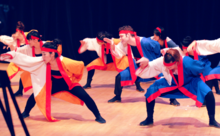| This article needs additional citations for verification. Please help improve this article by adding citations to reliable sources. Unsourced material may be challenged and removed. Find sources: "Sōran Bushi" – news · newspapers · books · scholar · JSTOR (October 2008) (Learn how and when to remove this message) |
You can help expand this article with text translated from the corresponding article in Japanese. (March 2020) Click for important translation instructions.
|

Sōran Bushi (ソーラン節) is one of the most famous traditional songs and dance (min'yō) in Japan. It is a sea shanty that is said to have been first sung by the fishermen of Hokkaido.
The commonly known version of the song and dance is called Nanchū Sōran (南中ソーラン) and was created in 1991 at the Wakkanai Minami Junior High School. It uses the song and text of Takio Ito's Takio no Sōran Bushi from 1988, which is a modernized version of the original song with a faster rhythm and a more modern music and text. The choreography was developed by the Butoh dancer Jushō Kasuga, which includes acting ocean waves, fishermen dragging nets, pulling ropes and lifting luggage over their shoulders. The school received an honorable mention at the Folk Song and Dance Awards National Convention in 1992, and one year later the Grand Prix of the Prime Minister of Japan. This made the song and dance nationally known, so that this dance is taught in many schools across Japan as part of the curriculum.
During regular intervals of the dance, the words "Dokkoisho! Dokkoisho!" and "Soran! Soran!" are called. Those words were used in the past to encourage the fisherman during their work.
Lyrics and translation
An excerpt from one of the many text versions of "Sōran Bushi"
|
Japanese (Rōmaji): Yāren sōran sōran CHORUS (kakegoe) Yāren sōran... Yāren sōran... Yāren sōran...
|
Rough English Translation: Oh!!! Soran, soran, soran CHORUS Oh!!! Soran... Oh!!! Soran... Oh!!! Soran... |
References
- "南中ソーラン | 稚内市立稚内南中学校" (in Japanese). 2019-05-15. Retrieved 2021-02-07.
This article related to the music of Japan is a stub. You can help Misplaced Pages by expanding it. |
This dance-related article is a stub. You can help Misplaced Pages by expanding it. |